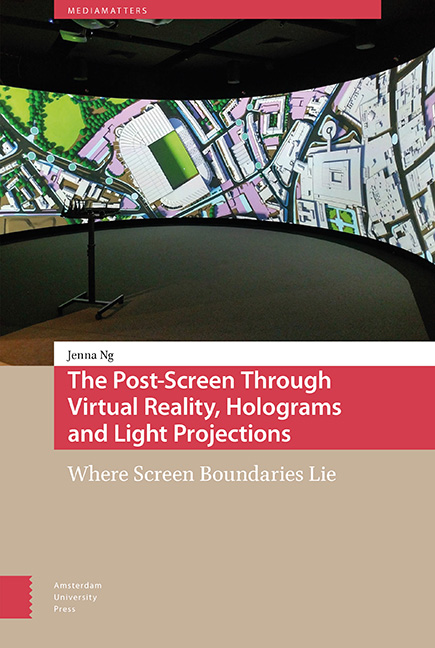 The Post-Screen through Virtual Reality, Holograms and Light Projections
The Post-Screen through Virtual Reality, Holograms and Light Projections Book contents
- Frontmatter
- Dedication
- Table of Contents
- Acknowledgements
- Introduction
- 1 Screen Boundaries as Movement
- 2 Leaking at the Edges
- 3 Virtual Reality: Confinement and Engulfment; Replacement and Re-placement
- 4 Holograms/Holographic Projections : Ghosts Amongst the Living; Ghosts of the Living
- 4A (Remix) True Holograms: A Different Kind of Screen; A Different Kind of Ghost
- 5 Light Projections: On the Matter of Light and the Lightness of Matter
- Conclusion/Coda
- Index
1 - Screen Boundaries as Movement
Published online by Cambridge University Press: 16 December 2021
- Frontmatter
- Dedication
- Table of Contents
- Acknowledgements
- Introduction
- 1 Screen Boundaries as Movement
- 2 Leaking at the Edges
- 3 Virtual Reality: Confinement and Engulfment; Replacement and Re-placement
- 4 Holograms/Holographic Projections : Ghosts Amongst the Living; Ghosts of the Living
- 4A (Remix) True Holograms: A Different Kind of Screen; A Different Kind of Ghost
- 5 Light Projections: On the Matter of Light and the Lightness of Matter
- Conclusion/Coda
- Index
Summary
Abstract
This chapter lays down the starting point for conceptualizing the postscreen by articulating the screen in terms of its boundaries, rather than a surface filled with light. It clarifies screen boundaries as not merely the formal material edges around a lit surface, but an active interplay of movement between actual and virtual boundaries. The essence of the screen, then, is not so much in what it displays but its relational paradoxes between what is shown and not shown, hidden and revealed. A transformative space arises out of the paradoxical interplay, resulting in affective engagements with love, pleasure and information. However, interactivity diminishes the authority of screen boundaries, paving the way for the post-screen of eroded screen boundaries.
Keywords: screens; screenology; boundaries; frame; window; actual; virtual; interactive media
Re-placing the Screen: Play and Display, Appearance and Dis-appearance
We must abandon received definitions and categorizations of what constitutes a screen.
∼ Erkki HuhtamoThe villain in the 2019 Spider-Man film, Spider-Man: Far from Home, is unusual. Created by Stan Lee and Steve Ditko in 1964 for the thirteenth volume of The Amazing Spider-Man comic series, the antagonist character of Mysterio does not have an obvious superhuman power. He is unlike other villains in the series, such as Dr. Octopus, who had mechanical tentacles fused to the spine, or Vulture, who could fly (albeit via an electromagnetic harness).
Instead, Mysterio (or Quentin Beck, as he is also known) is a special effects whiz. In Far from Home, Mysterio (played by Jake Gyllenhaal) fools all the characters in the film, including Spider-Man (played by Tom Holland), with large-scale holographic illusions created from Augmented Reality (AR) projectors mounted on flying drones. These illusions appear as realistic multi-sensorial simulations which surround Spider-Man, even following him as he moves. Most importantly, they do not seem to be contained within any kind of screen or framing boundaries.
The twist in the film, then, is that simulation itself becomes an antagonist. The real threat in this superhero world is not the usual death and destruction wrought by the villain, but the bewilderment and disorientation in being unable to distinguish between the actual and the virtual.
- Type
- Chapter
- Information
- The Post-Screen through Virtual Reality, Holograms and Light ProjectionsWhere Screen Boundaries Lie, pp. 51 - 78Publisher: Amsterdam University PressPrint publication year: 2021


